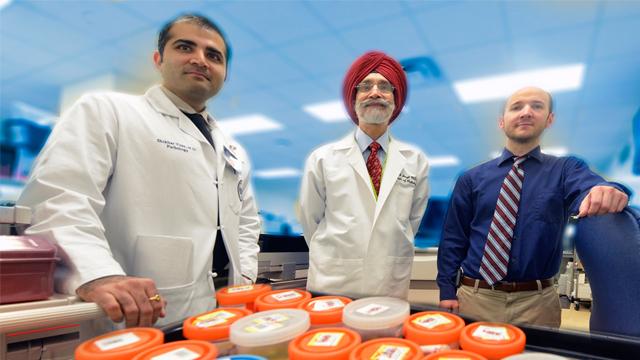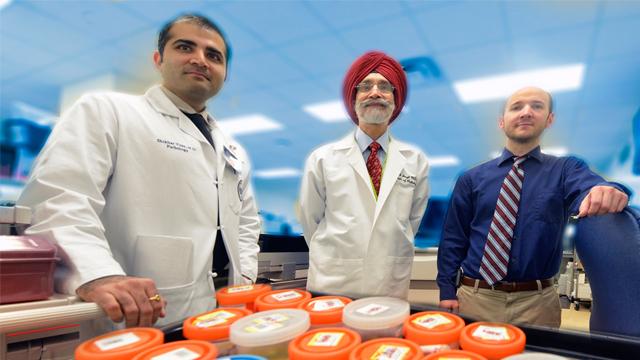
AUGUSTA, Ga. – A series of tests physicians routinely order to help diagnose and follow their patients with an elevated antibody level that is a marker for cancer risk, often do not benefit the patient but do increase health care costs, pathologists report.
A study in The American Journal of Clinical Pathology suggests that instead of ordering individual tests, physicians request an initial workup for the age-related disorder, monoclonal gammopathy, said Dr. Gurmukh Singh, chief of the Section of Clinical Pathology and Walter L. Shepeard Chair in Clinical Pathology at the Medical College of Georgia at Augusta University.
Once pathologists interpret results of a screening serum protein electrophoresis – which identifies which and how much of the excessive antibody, or immunoglobulin, called M-protein, is present – and examine the patient's medical record, they can decide in a stepwise fashion what, if any, additional tests are needed, said Singh, the study's corresponding author.
What Singh found instead in a fourth-month review of experience at a medium-sized teaching hospital in Georgia as well as an earlier study in Missouri, is that nearly half the time, well-intended physicians treating the patients are ordering tests that don't ultimately benefit their patients.
This study reviewed the history of 237 patients age 19-87 who had a total of 1,503 episodes of testing. In addition to serum protein electrophoresis, or SPEP, many patients also had serum immunofixation electrophoresis – which also helps detect the level and type of excessive antibody – and/or serum free light chain assays, which likewise provide a precise measure of the antibody level. A patient's physician may order this series of tests dozens of times over several months.
"About 40-50 percent of the second tests are not needed or adding value," said Singh, who, along with his colleagues, propose an algorithm that would put more of the decision-making in the hands of pathologists interpreting the tests and could improve those percentages at the nation's hospitals.
"These are stepwise things. If it's a new patient, do this; if it's a known patient, do that. Results drive it. That will reduce the number of tests that are done without in any way being of detriment to the patient or the quality of care," Singh said.
Examples of when the two subsequent – and more expensive – tests would be done at least once, is in a new patient when M-protein is first found, he said. The additional tests might also be beneficial for patients under treatment for multiple myeloma, to ensure that there are no trace amounts left of the abnormal protein.
In the series of tests they examined, only 46 percent of the serum immunofixation electrophoresis and 42 percent of the serum free light chain assays were warranted, the researchers report. They found the two tests were ordered multiple times in patients in whom the antibody, or monoclonal protein, were easily detected with SPEP. In fact, for most patients with measurable levels of M-protein, SPEP can be used to follow the course of the disease and treatment, they write.
"…(T)esting should be algorithmically driven rather than indiscriminate testing and repeating the same without evidence for clinical value," they continue. Electronic medical records enable these more rigorous approaches by pathologists. Similar approaches could be used for numerous other diseases, such as celiac disease, where a battery of tests also are routinely ordered and a stepwise approach might be more prudent, Singh said.
The typically benign monoclonal gammopathy results when a plasma cell in the body inexplicably starts producing too much of one type of antibody. Depending, primarily on the level of this M-protein, the condition can be essentially harmless or may result in the cancer multiple myeloma, which causes extreme fatigue, fragile bones, infections, kidney problems and more.
SPEP separates proteins into five groups according to their electrical charge, and the M-protein shows up as a peak on a graph as well as a distinctive, dense band of color, while typical antibody levels create just a smear.
"When patients are treated, the level of this protein goes down. If the tumor recurs, the level of the protein goes up," Singh said.
He notes that use patterns similar to the ones he saw in Georgia and Missouri are in play in hospitals across the nation. A protocol similar to the one he now proposes has safely enabled up to a 60 percent reduction in the volume of second tests at the Missouri hospital where it has been in use for about eight years.
"It's better for patients and for health care delivery in general," Singh said. The cost to the health care system for the unwarranted tests in the Georgia study would have been about $64,000 for just this one test at one hospital. Multiply that number by the number of hospitals and tests done nationally, and it becomes many millions, Singh said. He notes that his recommendations are a financial disincentive to pathologists such as himself who will be analyzing fewer test results and being paid less as a result. Physicians ordering the tests don't benefit financially either, he added.
"Why spend money that you don't need to spend when you are not gaining information that will benefit the patient's outcome," Singh said.
There are at least three gradations of monoclonal gammopathy, which are determined by the number of plasma cells in the bone marrow and the amount of M-protein circulating in the blood. Monoclonal gammopathy of undetermined significance means M-protein is present but not causing problems, although these individuals do have about a 1 percent increased risk of cancer. The next grade is smoldering myeloma, which as the name implies, denotes a higher cancer risk – about 10 percent – for multiple myeloma. The first two grades are typically not treated but patients are closely followed. The third grade, multiple myeloma, when plasma cell and M-protein levels reach a critical mass, is typically treatable, sometimes with a combination of chemotherapy and a stem cell transplant.
At these dramatically increased levels, antibodies, or M-proteins, can become harmful rather than helpful, destroying normal cells and causing lesions and fractures in the bone. "They can grow in localized areas or throughout in the bones and destroy the bone and that is where sometimes fractures occur," Singh said.
He notes that the cause of monoclonal gammopathy is unclear, but the risk tends to increase with age. Patients may present with unexplained fatigue, anemia or potentially deadly pneumococcal pneumonia, bone pain and fractures. Some physicians will specifically screen for the conditions in their patients over age 50, but it's not usually detectable from routine lab tests, Singh said.
###
Media Contact
Toni Baker
[email protected]
706-721-4421
@GRMedCenter
http://www.mcghealth.org
The post Excessive tests don’t benefit patient, do increase cost in age-related immune disorder appeared first on Scienmag.





